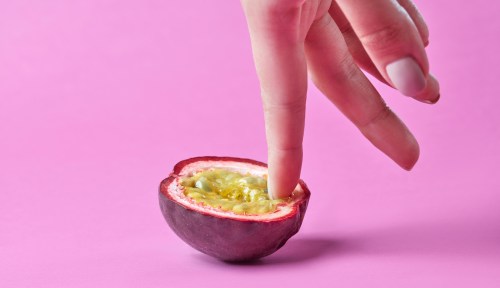Hey, great news: It turns out yeast infections can be contagious
It's rare, but women can pass yeast infections to their partners through sex, and vice versa. Here, a doctor outlines the symptoms and how to treat them.

Pop quiz: What do amoxicillin, rosé, and wet bathing suits have in common? If you’re thinking Duh, they’re all yeast infection triggers, you’ve clearly been reading Well+Good and you get a gold star. But if you’re avoiding all of these things and you’re still dealing with a yeast infection that just won’t quit, you may want to consider a lesser-known source—your partner.
As you’re likely aware, a genital yeast infection occurs when there’s an overgrowth of a fungus called candida in one’s nether regions. What you may not know is this fungus can be transferred back and forth (and back again) between partners of both sexes while getting busy, says Natasha Bhuyan, MD, a physician at One Medical in Phoenix, AZ. “Technically, yeast infections can be sexually transmitted, but we don’t call them sexually transmitted infections because people can get them in other ways,” she says.
Okay, don’t freak out if you’ve done the dirty while candida-afflicted: Only about 15 percent of men will catch a yeast infection if they’ve had unprotected sex with a woman who has one. (Researchers haven’t figured out an exact likelihood in female couples—or the chance of a woman catching a yeast infection from a man—even though it does happen. What up, medical research gender gap.) But there are certain risk factors that make some people more predisposed than others, says Dr. Bhuyan, including antibiotic use, diabetes, and poor hygiene. “It’s more common in men who are uncircumcised, as the yeast can get trapped under the foreskin and grow,” the doctor adds. And for women, birth control and douching can up the odds of yeast gone wild.
So how do you know if a yeast infection’s taken up residence in your relationship? For women, it’s pretty obvious when candida’s out of control—the itching and burning in your lady bits and telltale cottage cheese-like discharge tend to give it away. That’s not always the case for men, however. While some guys experience redness, pain, itching, or a scaly rash on the head of their penis—a condition called balanitis—Dr. Bhuyan says that many don’t show symptoms of yeast overgrowth at all. (Of course they don’t.) And in these cases, men could be exposing their partners to fungal overload without even realizing it.
Needless to say, if you or your bae are showing any symptoms of a yeast infection, you should head to the doctor ASAP. “Most people need an anti-fungal medication,” says Dr. Bhuyan. Your MD will likely prescribe either a single-dose oral pill or a topical cream to help clear up the problem—and you should refrain from getting busy until the meds have run their course, Dr. Bhuyan says. “You want to protect your partner, but there’s also there’s also a lot of inflammation when you get a yeast infection and you’re more susceptible to picking up STIs,” she explains. “It’s just safer and better to abstain from intercourse until you’re fully recovered.” As if you needed an excuse to start listening to more podcasts.
If UTIs are getting you down, you could try these natural remedies—or even physical therapy.
Sign Up for Our Daily Newsletter
Get all the latest in wellness, trends, food, fitness, beauty, and more delivered right to your inbox.
Got it, you've been added to our email list.










